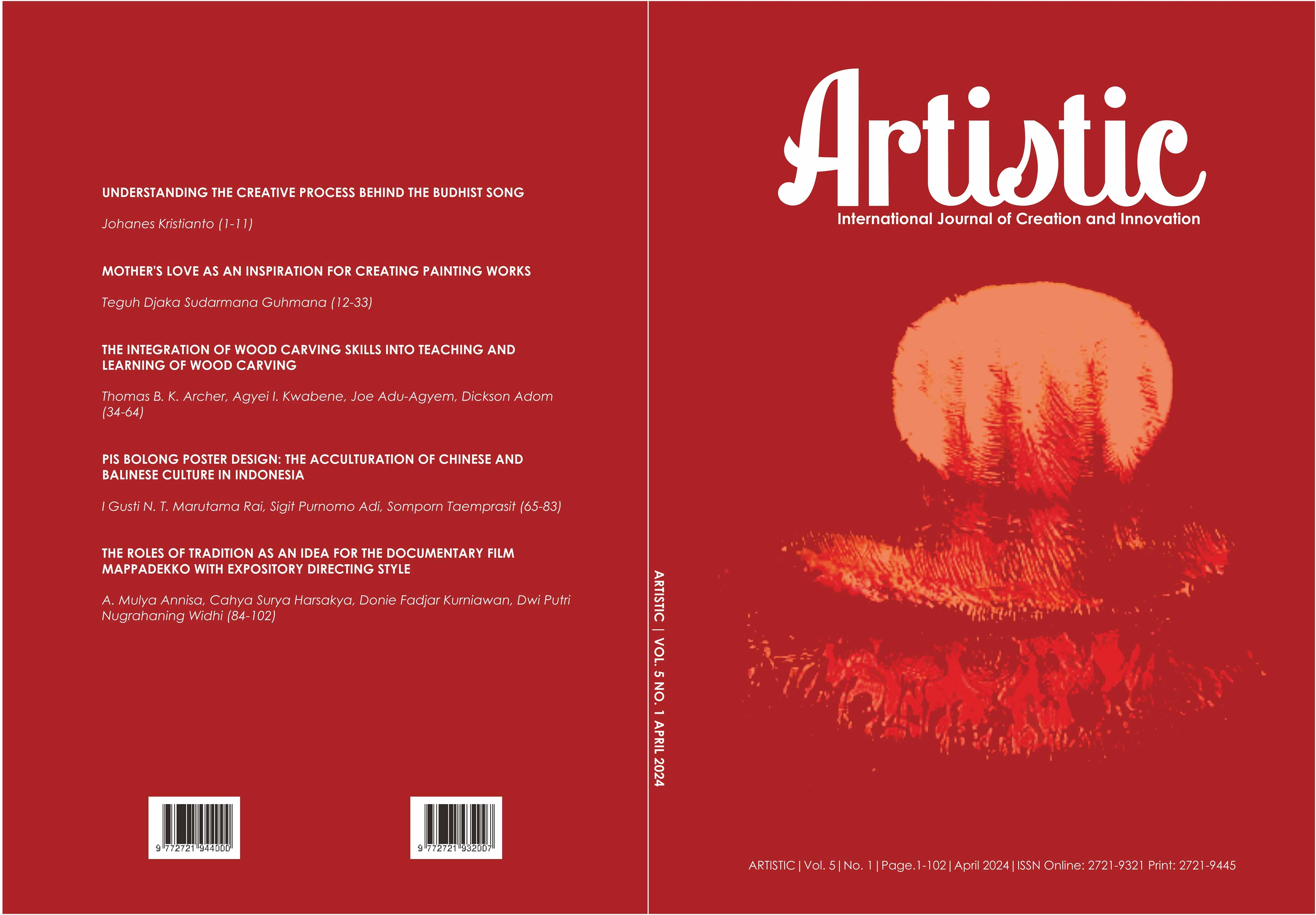UNDERSTANDING THE CREATIVE PROCESS BEHIND THE BUDHIST SONG
DOI:
https://doi.org/10.33153/artistic.v5i1.6230Keywords:
Creative Process, Songwriting, Buddhist Song, Breathing In Breathing OutAbstract
This study explores the creative process behind the Buddhist hymn Breathing In Breathing Out, specifically chosen for its recognized association with Buddhist meditation techniques. The study employs a qualitative methodology, involving five informants who possess expertise in music studies and Buddhism. Its objective is to investigate the process of creating Buddhist songs and analyze their influence on listeners. The results indicate that 1) songwriting for Buddhism is generally a voluntary pursuit without any external financial support or specified objectives, and 2) the creative process adheres to the four stages suggested by Graham Wallas. Furthermore, the practice of Breathing In Breathing Out has a beneficial impact on listeners’ mental well-being, improving mental conditions through enhanced concentration, focus, and self-acceptance.
Downloads
References
Hahn, D. M. (2015). An Investigation of the crative process in songwirint in an undergraduate songwriting survey class. Boston University.
Jones, C. S. (2013). The Basic Elements of Music. Textbook Equity.
Karsono. (2016). Proses Kreatif A. T. Mahmud dalam Penciptaan Lagu Anak-Anak. Dewa Ruci: Jurnal Pengkajian Dan Penciptaan Seni, 7(1). https://doi.org/https://doi.org/10.33153/dewaruci.v7i1.973.
Kristianto, J. (2022). Creative Learning in COVID-19 Pandemic: Case Study in Major Subject, Music Ministry Department-The Way Bethel Theological Institute. International Journal of Creative and Arts Studies, 9(1). https://doi.org/https://doi.org/10.24821/ijcas.v9i1.7065.
Liu, C. (2018). Reciting, Chanting, and Singing: The Codification of Vocal Music in Buddhist Canon Law. Journal of Indian Philosophy, 46(4), 713–752.
Mayer, R. E. (1989). Cognitive views of creativity: Creative teaching for creative learning. Contemporary Educational Psychology, 14, 203–211. https://doi.org/https://doi.org/10.1016/0361-476X(89)90010-6.
Nowak, R. (2016). Consuming Music in the Digital Age: Technologies, Roles and Everyday Life. Springer.
Oleynick, V. C. … Kieffaber, P. D. (2014). The Scientific Study of Inspiration in The Creative Process: Challenges and Opportunities. Frontiers in Human Neouroscience: Hypothesis and Theory Article, 8.https://doi.org/10.3389/fnhum.2014.00436.
Runco, M. A., & Jaeger, G. J. (2012). The Standart Definition of Creativity. Creativity Research Journal, 24(1), 92–96. https://doi.org/https://doi.org/10.1080/10400419.2012.650092.
Sadler-Smith, E. (2015). Wallas’ Four-Stage Model of the Creative Process: More Than Meets the Eye? Creativity Research Journal, 27(4), 342–352. https://doi.org/https://doi.org/10.1080/10400419.2015.1087277.
Wallas, G. (1926). The art of thought. Harcourt, Brace and Company.
Wigati, O. T. N. … Nugrahanto, W. (2022). The Construction of Indie Music Fandom Identity on Instagram. CAPTURE : Jurnal Seni Media Rekam, 14(1), 61–74. https://doi.org/10.33153/capture.v14i1.4465.
Downloads
Published
How to Cite
Issue
Section
License
Copyright (c) 2024 Johanes Kristianto

This work is licensed under a Creative Commons Attribution-NonCommercial-ShareAlike 4.0 International License.
Copyright
Authors who publish with Artistic agree to the following terms:
- Authors retain copyright and grant the journal right of first publication with the work simultaneously licensed under a Creative Commons Attribution License (CC BY-SA 4.0) that allows others to share the work with an acknowledgment of the work's authorship and initial publication in this journal.
- Authors are able to enter into separate, additional contractual arrangements for the non-exclusive distribution of the journal's published version of the work (e.g., post it to an institutional repository or publish it in a book), with an acknowledgment of its initial publication in this journal.
This work is licensed under a Creative Commons Attribution-ShareAlike 4.0


